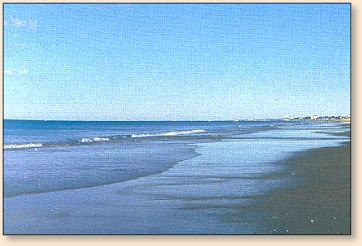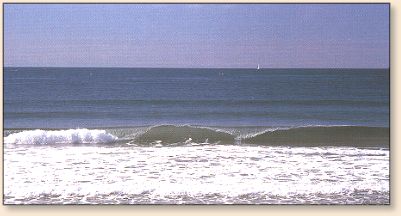Sight-fishing beaches are spectacular. They come
in many sizes but most often they are long - interlocking
land and sea for miles with restless surf. The in
unquestionably the most challenging environment in
which to sight-fish. It is also the most exciting
and a consistent producer of trophy stripers.

Sight-fishing beaches are perfect for wade-fishermen.
Their direct contact with the open sea ensures surf,
clean water and an intertidal zone, all elements for
making them productive sight-fishing beaches. Working
from a skiff here is both ineffective and unsafe.
Wading is the only way to effectively stalk your
quarry and maneuver in this dynamic environment
while making complex presentations to fast-moving targets.
The surf is an exhilarating, high-skill environment
for sight-fishers. This is perhaps the most athletic
fly-fishing there is. Fishing the surf often calls
for miles of brisk wading, both out of the water in
soft sand and in knee-deep wash. Occasionally,
anglers may remain stationary for long periods by
posting-up, but more often they burn calories and
they're not afraid to get wet. Unlike other
sight-fishing waters, anglers frequently spot fish
well beyond casting range and are able to successively
reposition themselves for several presentation to
the same fish.
The surf is by far the most sensitive sight-fishing
environment to adverse natural and human influences.
In addition to the usual factors of wind, sun and
water clarity, beaches are also at the mercy of the
open sea through incoming waves and by widespread
human activity. The pristine features that make a
beach a sight-fishing beach are the same ingredients
that make these shorelines ideal for beach-goers of
all sorts. If the surf has a pitfall it is its
vulnerability to the ocean, weather and excessive
human activity.
Bathers are usually unaware of the stripers around
them, which often feed around their legs and feet.
These swimmers are understandably not fond of hooked
lures being cast in their direction and hence they
pose an obstacle for fly-fishers. A continuous
stream of pedestrians along the water's edge adds
yet another variable that anglers must remain aware
of as far as the backcast is concerned. Sight-fishing
on popular beaches at the height of the season may
be more bother than it's worth, especially on beaches
that cater to sunbathers and discourage fishermen
during the day. Exercising your right to fish in
public waters below the high-tide line (that is the
law in most Northeast states) on state-run or
privately maintained beaches where life guards are
on duty is generally more hassle than it's worth
however. These beaches are far less crowded in the
off-seasons of June and September when the fishing
is perhaps best anyway.

Above all else, it is important to be constantly aware
that the Northeasts' spectacular beaches are for
everyone. Anglers must keep this in mind, regardless
of where and when the fish show up. Prudent anglers
who carefully work around bathers and beach-walkers
are rarely bothered and instead they are often cheered
by galleries of fascinated onlookers when they hook,
play and release a trophy striper. When beaches become
so crowded that fishing becomes frustrating it is a wise
anglers who elects to put the rod down and spend a day
observing his quarry to better understand its behavior
in preparation for another day. ~ Alan Caolo
Credits: Excerpt and photo from Sight-Fishing
for Striped Bass Fly-Fishing Strategies for Inshore,
Offshore and the Surf, by Alan Caolo, Published by Frank
Amato Publications. We appreciate use premission. |


